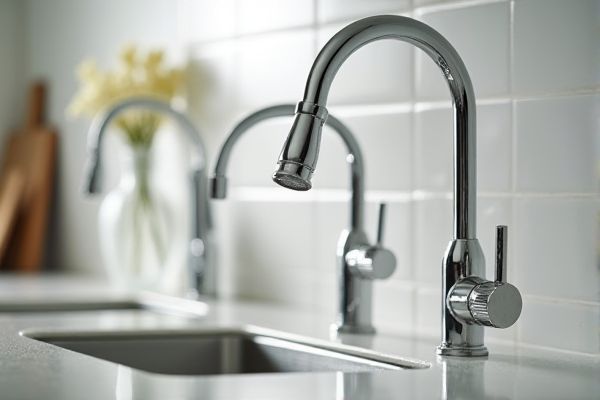
Two-handle faucets offer precise temperature control by allowing independent adjustment of hot and cold water, while single-handle faucets provide ease of use and quick temperature changes with one lever. Discover which faucet type best suits Your needs by exploring the advantages and drawbacks detailed in the rest of this article.
Table of Comparison
| Feature | Two-Handle Faucet | Single-Handle Faucet |
|---|---|---|
| Control | Separate handles for hot and cold water | One handle controls both temperature and flow |
| Installation | More complex, requires two holes | Simpler, usually requires one hole |
| Temperature Adjustment | Manual mixing of hot and cold | Easy single-hand temperature adjustment |
| Maintenance | More parts, potentially higher maintenance | Fewer parts, generally easier maintenance |
| Design | Classic or traditional look | Modern and streamlined appearance |
| Water Efficiency | Moderate efficiency | Often designed for better water conservation |
Introduction to Faucet Handle Types
Two-handle faucets feature separate controls for hot and cold water, allowing precise temperature adjustments, while single-handle faucets integrate both controls into one lever for streamlined operation. Single-handle models often simplify installation and maintenance, making them ideal for modern kitchens or bathrooms, whereas two-handle faucets offer a classic aesthetic and fine-tuned water flow control. Your choice between these faucet handle types depends on your preference for ease of use, design, and temperature regulation needs.
Key Differences Between Two-Handle and Single-Handle Faucets
Two-handle faucets feature separate controls for hot and cold water, allowing precise temperature adjustment, while single-handle faucets use one lever to control both temperature and flow, offering convenience and ease of use. Two-handle models often provide a more traditional aesthetic and are preferred for vintage or classic bathroom designs, whereas single-handle faucets suit modern environments with streamlined functionality. Installation complexity tends to be higher for two-handle faucets due to dual connections, while single-handle faucets generally require less space and simpler plumbing setups.
Design and Aesthetic Considerations
Two-handle faucets offer a classic, symmetrical design that enhances traditional or vintage bathroom and kitchen aesthetics, allowing precise control over hot and cold water separately. Single-handle faucets provide a sleek, modern look with streamlined functionality that suits contemporary, minimalist interiors by controlling temperature and flow with one lever. Your choice between these faucets will impact the overall design harmony and user experience in your space.
Installation Process and Complexity
Two-handle faucets generally require more complex installation as they need separate connections for hot and cold water lines, often requiring precise alignment and multiple holes drilled in the sink or countertop. Single-handle faucets offer a simpler installation process with a single mount point and fewer plumbing connections, making them ideal for quick and straightforward setups. Homeowners and professionals often prefer single-handle faucets for renovations due to reduced installation time and lower risk of leaks or misalignment.
Ease of Use and Accessibility
Single-handle faucets offer greater ease of use by allowing precise control of water temperature and flow with one hand, making them more accessible for individuals with limited mobility or dexterity. Two-handle faucets require using both hands to adjust hot and cold water separately, which can be challenging for people with arthritis or physical disabilities. Single-handle designs often incorporate ergonomic features that enhance accessibility in kitchens and bathrooms, providing a more user-friendly experience.
Temperature and Flow Control Precision
Two-handle faucets offer precise temperature control by allowing independent adjustment of hot and cold water, enabling users to find an exact blend. Single-handle faucets provide smoother flow regulation with one lever managing both temperature and flow, simplifying use but sometimes sacrificing fine-tuning accuracy. For tasks requiring specific temperature settings, two-handle faucets deliver greater control, while single-handle models prioritize convenience and quick adjustments.
Maintenance and Durability Factors
Two-handle faucets typically offer easier maintenance due to separate control valves that isolate hot and cold water, reducing wear on each handle and simplifying repairs or part replacements. Single-handle faucets, while often more prone to wear in the mixing cartridge, benefit from fewer overall components, which can lower the risk of leaks but may require full cartridge replacement during maintenance. Durability for both types depends largely on the quality of materials, with brass or stainless steel fixtures lasting longer and resisting corrosion compared to plastic components.
Cost Comparison: Upfront and Long-Term
Two-handle faucets generally have a higher upfront cost due to their complex design and installation requirements, whereas single-handle faucets typically offer a more budget-friendly initial purchase and easier installation. Over the long term, single-handle faucets tend to incur lower maintenance costs because their simpler mechanism reduces the likelihood of leaks or component failures. However, two-handle faucets may offer better durability and customization options, potentially extending their lifespan with proper care and making cost efficiency depend on specific usage and maintenance patterns.
Water Efficiency and Conservation
Two-handle faucets allow precise control over hot and cold water, which can help reduce water waste by enabling you to adjust temperatures quickly and avoid unnecessary water flow. Single-handle faucets offer faster temperature regulation with one motion, promoting water conservation by minimizing the time water runs while adjusting temperature. Both designs impact water efficiency, but your choice can depend on how you prioritize ease of use versus temperature precision in daily water conservation.
Choosing the Right Faucet Handle for Your Needs
Two-handle faucets offer precise control over hot and cold water temperature, ideal for tasks requiring exact adjustments, while single-handle faucets provide convenience and ease of use with one-handed operation. Consider installation space and maintenance; single-handle models typically require less repair due to fewer moving parts, whereas two-handle faucets may suit traditional or larger sinks with separate hot and cold water lines. Selecting between these faucet types depends on your priority for temperature accuracy, ease of use, and bathroom or kitchen design aesthetics.
 homyna.com
homyna.com